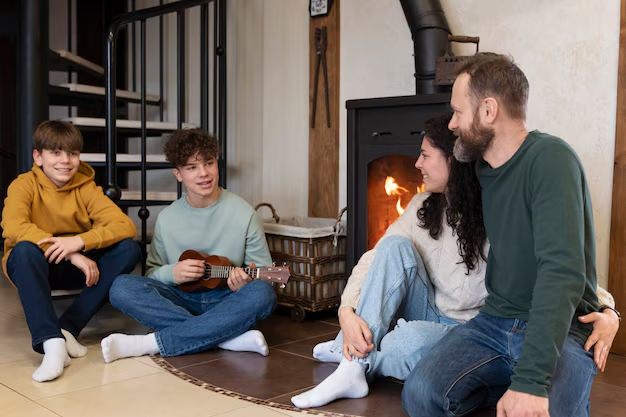Warm Homes Local Grant
Keeping your home warm and affordable to run is not always easy. Energy prices keep rising, and many households across the UK struggle with high bills and draughty rooms. What a lot of people don’t know is that local councils now have access to dedicated funding that can help. This support is known as the Warm Homes Local Grant.
Funded through the UK Government but delivered by local authorities, the scheme provides money for practical home improvements that cut down energy use. The focus is simple: reduce fuel poverty, improve the efficiency of homes, and lower carbon emissions at the same time.
At Free Energy Savings, our role is to make the process straightforward. We connect you with the right council-backed funding in your area and guide you through each step, from the first check to the final installation. That way you don’t have to figure out the paperwork on your own.
Apply Now For The Warm Homes Local Grant
Fill out the form below to take advantage of the Warm Homes Local Grant.
By submitting this form, you consent to us contacting you by phone, SMS, or email regarding your Warm Homes Local Grant application. We will not use your details for unrelated marketing. See our Privacy Policy for more. You can opt out at any time.

3 Step Eligibility Process

Complete Online Form
Fill out our quick online form to apply for your ECO 4 Grant.

Get a Survey
Schedule a free home survey to assess your property’s heating system and energy needs.

Get an ECO 4 Grant
Receive a grant for a brand new, heating system or insulation at no cost.
What Is the Warm Homes Local Grant?
The Warm Homes Grant, sometimes called the Local Authority Delivery (LAD) scheme, is government-backed funding made available through your local council. In simple terms, it’s a way for councils to provide energy-saving home upgrades directly to households that need them most.
The funding is targeted at homes that are harder to heat or households living on a lower income. Instead of being run by a single national body, councils are given the budget and flexibility to decide how the money is spent in their area. That means the exact measures available may vary, but the purpose is always the same: improve energy efficiency, cut bills, and make homes more comfortable to live in.
Upgrades usually include things like insulation, heating system replacements, and in some areas renewable options such as solar panels or air source heat pumps. Many households who just miss out on ECO4 funding find that they can still qualify under the Warm Homes scheme, making it a valuable safety net.
In some parts of the country, Warm Homes also links to the Home Upgrade Grant (HUG), another government initiative designed to help properties that aren’t connected to the gas grid. Put simply, this is all part of a wider effort to reduce fuel poverty and cut carbon emissions across the UK.
Why is this important? Because millions of households still live in homes that are classed as EPC band D or worse. These homes cost more to heat, lose energy quickly, and put strain on both budgets and health. By funding practical improvements through local councils, the Warm Homes Grant helps bridge that gap.
If you’re unsure whether your home qualifies, the best first step is to check what your local council currently offers. That’s where we can help: Free Energy Savings works with installers nationwide and keeps track of which councils are running the scheme right now.
What Upgrades Can the Warm Homes Grant Cover?
One of the main advantages of the Warm Homes Grant is the variety of upgrades it can support. Because the scheme is managed locally, councils can tailor what’s offered depending on the housing stock in their area. That means the help available in one city may look a little different to another, but the focus is always the same: improving the efficiency of homes and cutting bills.
Here are some of the most common improvements covered:
- Loft insulation – stopping heat from escaping through the roof and keeping rooms warmer for longer.
- Cavity wall insulation – filling gaps between external walls to reduce draughts and energy loss.
- Solid wall insulation – for older homes without cavities, external or internal wall insulation can make a huge difference.
- Boiler replacements and central heating upgrades – replacing outdated, inefficient systems with modern, cost-effective options.
- Air source heat pumps – available in certain councils, providing renewable heating that reduces reliance on gas.
- Solar PV panels – some areas also support solar power, helping households generate their own electricity.
There are also smaller but still useful measures that can be included. Things like draught proofing, improved heating controls, or smart thermostats can help maximise efficiency after the main work is done.
Not every council offers every measure, so it’s worth checking exactly what’s available where you live. The upgrades are always designed to deliver a step-change in your Energy Performance Certificate (EPC) rating, which doesn’t just lower bills but can also increase the long-term value of your home.
Think of it as a package designed to tackle the biggest sources of wasted energy in your property. For one household, that might mean better loft insulation and a new boiler. For another, it could involve external wall insulation and solar panels. The aim is always the same: warmer, more affordable living.
Warm Homes Grant Eligibility – Who Qualifies?
Eligibility is often the first question people have about any grant. With the Warm Homes scheme, the rules are set by local councils, but there are some common factors most areas follow.
In general, the scheme is designed for households that find it hardest to keep their homes warm. That usually means:
- Low-income households – in most councils, this is a combined annual income of under £30,000.
- Homes with lower EPC ratings – typically band D to G properties, as these lose more heat and cost more to run.
- Fuel-poor or vulnerable households – where energy costs take up a large share of income, or where residents may be at greater risk from cold homes.
Some councils go a step further. They may extend eligibility to:
- Households on specific means-tested benefits.
- Tenants, provided their landlord agrees to the work.
- People with health conditions made worse by cold or damp homes.
It’s important to understand that each council has the final say on the details. One local authority may set slightly different income thresholds, while another may focus more heavily on certain property types. Still, the common thread across all of them is supporting people who would benefit most from lower energy bills and warmer living conditions.
What if you don’t qualify for ECO4 or GBIS? That’s where Warm Homes can help. Many households who fall just outside the strict rules of national schemes still find they are eligible under their local council’s version of the grant. It’s a way of bridging the gap, ensuring fewer people are left without support.
For example, a pensioner in Northampton who didn’t qualify under ECO4 rules was able to access Warm Homes funding through the council. They received a new boiler installation, which now saves them over £400 each year on heating. Another case saw a family in Leicester qualify for external wall insulation through their local authority, cutting their annual bills by around £600. These are not one-off situations — they’re examples of how councils tailor funding to meet real needs.
If you’re wondering whether tenants can apply, the answer is yes, as long as the landlord gives permission. Councils want to make sure private rental properties are efficient too, since tenants are often the ones struggling most with high bills.
Eligibility might sound complicated, but it doesn’t have to be. At Free Energy Savings, we help check the criteria for your area and confirm whether your household qualifies. That way you don’t waste time guessing or trying to interpret council guidelines.
How Much Can You Save with the Warm Homes Grant?
The savings from the Warm Homes Grant will depend on the type of upgrades your property receives. Some improvements have a bigger impact than others, but all of them are designed to make heating your home more affordable.
Here are some of the typical yearly savings households see:
- Loft insulation – £300 to £400 a year.
- Cavity wall insulation – £250 to £450 a year.
- Solid wall insulation – £500 to over £1,000 a year.
- Heating system upgrades – £400 to £900 a year, depending on your current system and the new installation.
These figures aren’t just about cutting costs on paper. They also mean warmer rooms in winter, fewer draughts, and a home that holds heat more effectively. For many families, that comfort is just as valuable as the financial savings.
Take one example: a couple in Nottingham applied through their council’s Warm Homes scheme and had cavity wall insulation installed. Their annual heating bills dropped by around £450, but they also noticed their living room stayed warmer in the evenings without needing the heating on as much. It’s a simple change with a real impact on everyday life.
There’s also a longer-term benefit. Improving your Energy Performance Certificate (EPC) rating can increase the value of your property, since buyers and tenants increasingly look for energy-efficient homes. For landlords, it can also mean meeting new minimum energy standards more easily.
Of course, the exact savings will vary depending on your home and your council’s funding. But the aim is always the same: reduce energy use, lower bills, and improve living conditions for households that need it most.
Warm Homes Application & Installation Process
Applying for the Warm Homes Grant may sound complicated, but the process is much simpler than most people expect. With Free Energy Savings, everything is broken down step by step so you know exactly what to expect.
Here’s how it usually works:
- Free eligibility check – Start online or give us a call. We’ll confirm whether your home and household meet the basic criteria.
- Survey arranged – A qualified surveyor visits your property to assess its Energy Performance Certificate (EPC), look at your current heating, and confirm income or benefit details.
- Application submitted – Once the survey is complete, we handle the paperwork and submit your application to the local authority.
- Funding confirmed – The council reviews the details and issues approval.
- Installation carried out – Certified installers complete the work, whether that’s insulation, heating upgrades, or renewable measures.
The whole process usually takes between 4 and 10 weeks, depending on how quickly your local authority processes applications and what type of upgrades are involved.
One common worry is hidden costs. With government-backed funding like Warm Homes, the work is fully covered or heavily subsidised. Many households pay nothing at all. And if a contribution is required in your case, you’ll always know upfront before any work begins.
Think of us as the link between you and your council’s funding. Instead of trying to figure out forms, deadlines, and technical details, you simply follow the steps while we take care of the process behind the scenes.

Why Choose Free Energy Savings?
With so many different funding schemes available, it can feel overwhelming to know where to start. That’s exactly why Free Energy Savings exists — to make sure households like yours don’t miss out on support they’re entitled to.
Here’s what sets us apart:
- Specialists in government-backed grants – We’ve helped households access ECO4, the Great British Insulation Scheme, the Boiler Upgrade Scheme, and Warm Homes funding.
- Nationwide network of certified installers – No matter where you live, we connect you with trusted local professionals.
- Free surveys and advice – You won’t pay for the initial checks or eligibility confirmation.
- End-to-end support – From your first application through to final installation, we take care of the paperwork and council requirements.
We know from experience that many people hesitate to apply because they worry the process will be slow or complicated. The reality is different. For example, a homeowner in Sheffield recently worked with us to apply for Warm Homes funding. Within just eight weeks, they had solid wall insulation installed at no cost, cutting their bills and making their home noticeably warmer.
Our role is to simplify things, keep you updated, and make sure the work is carried out properly. You won’t be left chasing the council or second-guessing what comes next — that’s our job.
Choose Free Energy Savings today and let us guide you through Warm Homes funding the easy way.

Ready to Apply for the Warm Homes Local Grant?
The Warm Homes Grant is one of the most practical ways local councils are helping households cut bills and live more comfortably. Funded by the UK government and delivered through local authorities, it gives low-income and fuel-poor households the chance to upgrade their homes with insulation, heating improvements, and sometimes even renewable technologies.
If you don’t meet the strict criteria for ECO4 or the Great British Insulation Scheme, Warm Homes could be the route that works for you. Each council sets its own rules, but the aim is always the same: reduce fuel poverty, improve energy efficiency, and help people feel warmer in their homes without extra strain on their budgets.
At Free Energy Savings, we make the process simple. From the first eligibility check to the final installation, our team connects you with the right funding, handles the council paperwork, and ensures the work is carried out by certified installers. No hassle, no confusion, just a clear path to getting the support you’re entitled to.
Don’t leave it to chance. Funding is often limited and delivered in phases by councils, which means acting sooner gives you the best opportunity to benefit.
Apply today to see if your local authority is offering Warm Homes funding for your home.
Frequently Asked Questions
The Warm Homes Grant is funding provided through local councils to help households improve their home’s energy efficiency. It’s part of the government’s Local Authority Delivery (LAD) scheme, which means councils are given budgets to support households in their area. The grant can cover insulation, heating system upgrades, and in some areas renewable measures like solar panels.
ECO4 and the Great British Insulation Scheme (GBIS) are national programmes with set eligibility rules across the country. Warm Homes, on the other hand, is managed by local councils, so the details vary by area. It often helps households who just miss out on ECO4 or GBIS, acting as a safety net.
You don’t need to be on benefits to qualify. Most councils set a household income threshold (often under £30,000 a year) and focus on homes with an EPC rating of D–G. If your income is limited but you don’t receive benefits, you could still be eligible.
Yes. Tenants can apply as long as their landlord agrees to the work. In fact, councils encourage upgrades in rental properties because tenants are often hit hardest by high energy bills. Landlords also benefit by improving the EPC rating of their properties, which is increasingly important for letting rules.
Typical measures include loft insulation, cavity wall insulation, solid wall insulation, boiler replacements, heating upgrades, air source heat pumps, and solar PV in some areas. Councils sometimes also fund secondary measures like draught proofing or smart heating controls. The exact package depends on where you live and your property type.
Not all councils currently offer Warm Homes funding. Each local authority decides when and how they deliver the scheme. Some run it in phases, others target specific neighbourhoods. That’s why the first step is always checking whether your council is participating.
It varies by area, but most households see the process move from application to installation within 4 to 10 weeks. A homeowner in Leicester, for example, applied in early spring and had their external wall insulation completed before the end of May.
In some cases, yes. Warm Homes can complement other funding, especially if one scheme doesn’t fully cover the upgrades you need. Each case is reviewed individually, but councils often try to maximise funding streams so households get the most support possible.
Councils usually ask for evidence of income (like payslips or tax credits) or proof of benefits if relevant. An EPC rating is also required, which is why a home survey is part of the process. Don’t worry if you don’t have a recent EPC — the survey arranged through Free Energy Savings includes this check.
Yes. Every upgrade funded through Warm Homes is designed to improve EPC ratings. The higher your rating, the less energy your home wastes and the more attractive it becomes if you ever sell or rent it out. Lower bills are the immediate benefit, but improved comfort and long-term property value are equally important.
Warm Homes funding is usually fully covered, meaning households don’t pay anything. In some cases, councils may require a small contribution, but this is always confirmed upfront before work begins. Most applicants pay nothing at all.
Not if you don’t want to. Free Energy Savings manages the process on your behalf, from checking eligibility to submitting the application and arranging installation. You’ll always be kept informed, but you won’t need to chase paperwork or worry about forms.
Funding often comes in phases. If your council isn’t currently running Warm Homes, we can help you explore alternatives like ECO4 or GBIS. We’ll also let you know when Warm Homes funding becomes available again in your area.

What Our Customers Have To Say
Read More Of Our Reviews On Trust Pilot
We’ve had some bad experiences with installers in the past, but Free Energy Savings was a breath of fresh air. They were helpful and patient, answering all of our questions about the ECO4 scheme and making sure we understood how it worked. The installation was done quickly and professionally, and the team was extremely respectful of our home.
- Jessica B
We were a bit unsure about how the ECO4 grant worked, but Free Energy Savings made everything so simple. The team explained every detail of the grant and the benefits from a new boiler installation. When it came time for the installation, they arrived right on schedule and worked hard to get everything set up. What impressed me most was the attention to detail….
- Amelia L
Free Energy Savings exceeded all of our expectations. From the moment we contacted them, they were responsive and informative. The team helped us through the paperwork for the ECO4 grant, which was a big help since we had no idea where to start. The installation crew was friendly, professional, and fast. It’s been a couple of months now, and we’re already…



